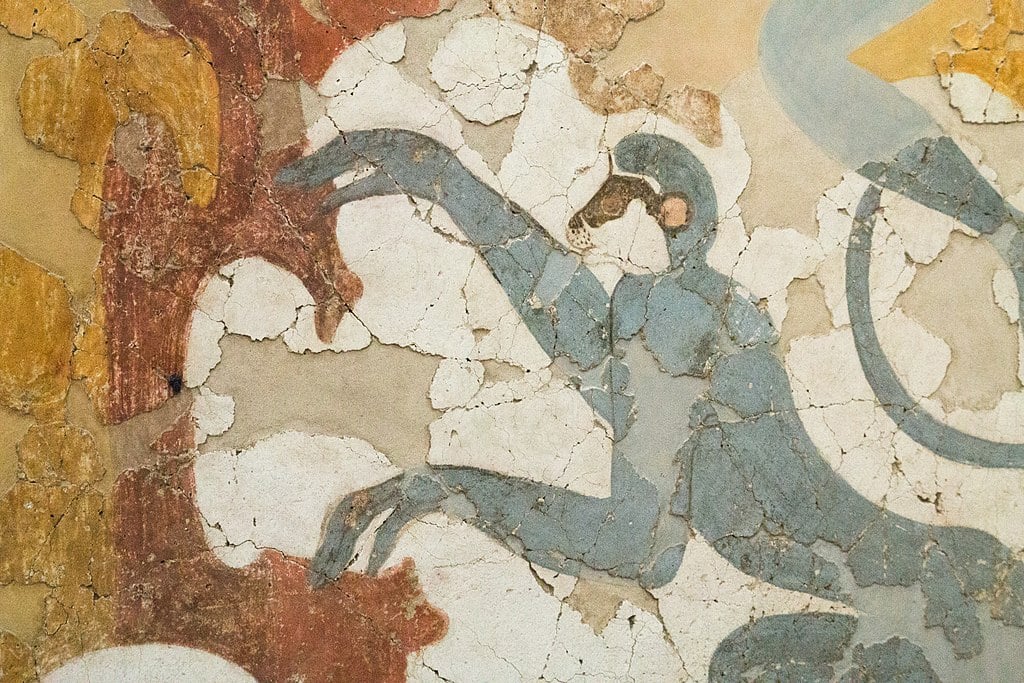
Scientists have debated the reason why Bronze Age wall paintings at the ancient settlement of Akrotiri on the Greek island of Santorini depict monkeys that existed thousands of miles away in Asia.
Some claim the works of art suggest that ancient cultures separated by great distances had clearly been trading and exchanging ideas for some time despite barriers and difficulties involved.
Akrotiri was a settlement of the Minoan civilization in Bronze Age Greece buried by ash from a volcanic eruption which occurred around 1600 BC.
Many of the paintings on the walls of buildings there clearly portray monkeys; yet, there is no archaeological evidence of monkeys in Greece at the time.
Most of the monkeys in the artwork have been identified as Egyptian species, such as olive baboons.
This makes sense because Egypt is known to have had contact with the Minoan civilization, which occupied several Aegean islands.

Monkeys depicted on Bronze Age Greek Frescoes from Indus Valley
However, as a New Scientist report recently revealed, the other primates depicted on the walls were grey langur monkeys. Their habitat includes southern Asia, or what is now Nepal, Bhutan, and India, and particularly the Indus Valley, home to one of the greatest ancient Bronze Age civilizations.
Somehow, the artist who painted the monkey mural must have seen a grey langur for himself.
Did Minoan Greeks visit the Indus Valley? “I wouldn’t be surprised if someday in the future we found evidence for that kind of direct contact,” says Marie Nicole Pareja at the University of Pennsylvania in Philadelphia.
Of course, it is also possible langur monkeys were brought to Greece, but again, there is no evidence, Pareja adds in her interview with the New Scientist.
Instead, it may be that Greece and Indus were connected via Mesopotamia, another great Bronze Age civilization centered in what is now Iraq.
Langurs may have been imported to Mesopotamia, where they were seen by visiting Greeks, for menageries.
“It’s evidence of this far-reaching trade, these relationships with these far-flung areas,” says Pareja. Hence, even in the Bronze Age, it seems there indeed was a great deal of exchange between these seemingly disparate and completely distant civilizations.
Akrotiri was destroyed in the Theran eruption sometime in the 16th century BC and buried in volcanic ash, which preserved the remains of fine frescoes and many objects and artworks.
The earliest evidence of human habitation of Akrotiri can be traced back as early as the fifth millennium BC when it was a small fishing and farming village.
By the end of the third millennium, this community developed and expanded significantly. One factor for Akrotiri’s growth may be the trade relations it established with other cultures in the Aegean, as evidenced in fragments of foreign pottery at the site.
Akrotiri’s strategic position on the primary sailing route between Cyprus and Minoan Crete also made it an important point for the copper trade, thus allowing it to become an important center for processing copper, as proven by the discovery of moulds and crucibles there.
Its prosperity continued for about another five hundred years. Paved streets, an extensive drainage system, the production of high-quality pottery and further craft specialization all point to the level of sophistication achieved by the settlement.
This all came to an end, however, in the 16th century BC with the volcanic eruption of Thera.
See all the latest news from Greece and the world at Greekreporter.com. Contact our newsroom to report an update or send your story, photos and videos. Follow GR on Google News and subscribe here to our daily email!



